Titus Canyon is one of the most spectacular backcountry drives in all of the US. Located in Death Valley National Park, this drive has so much variety, including mountain passes, massive canyons, ghost towns, petroglyphs, stunning geology, and more. The main event of this epic 27-mile drive is the Titus Canyon Narrows, a tight canyon with towering limestone walls. It’s like a slot canyon that you can drive your vehicle through!
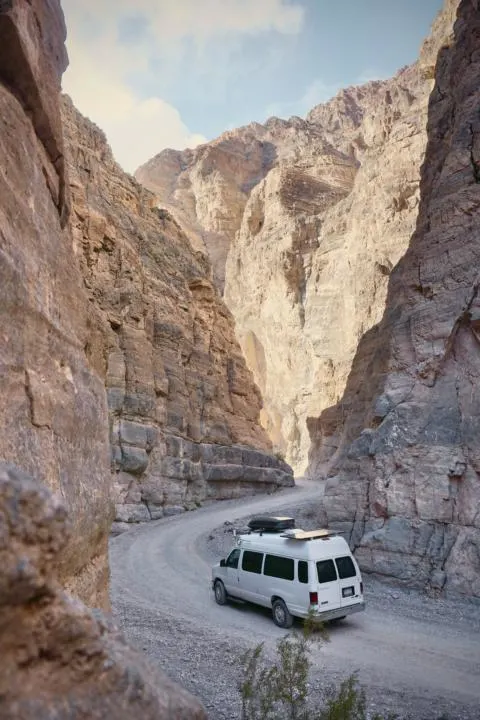
Emily and I were a little apprehensive about doing this drive in our 2wd campervan. But afterward, we are so happy to have experienced it. In dry conditions, the road was totally manageable in 2wd. However, high clearance we pretty essential in some spots. The scenery in Titus Canyon is on par with some of the best hikes we have ever done.
Details For Titus Canyon
[From National Park Website]
Vehicle Requirements: High-clearance, 2wd. 4wd may be necessary after bad weather
Distance: 27 miles
Time: 2-3 hours
Start: Nevada Highway 374 (Daylight Pass Road), 2 miles east of park boundary
Road Conditions: One-way road from east; this dirt road is rough, steep and narrow; often closed due to snow, mud, or washouts; two-way section from west is graded dirt road.
Warnings: Infrequently patrolled, summer travel not advised. Canyon prone to flash flooding, avoid entering when rain threatens. Ask at ranger stations for current road and weather conditions.
Start Of Drive For Titus Canyon
The beginning of the one-way drive starts just 2 miles east of the park boundary off NV Highway 374 (Daylight Pass Road). Say goodbye to pavement, because this is the last time you will see it for a while. (This is also one of the very few places with good cell reception anywhere near Death Valley, just FYI).
The beginning of the drive is rather unremarkable. The wide-open desert valley and constant washboard road make the first several miles of the drive a bit of a slog. But don’t worry that changes quickly.
Before you know it, you’ve started winding your way up into the Grapevine Mountains. Shortly thereafter, you cross the border from Nevada and enter into California. But you might as well be on another planet because other than the dirt road in front of you, the desert landscape is other-worldly.
Driving Up Red Pass
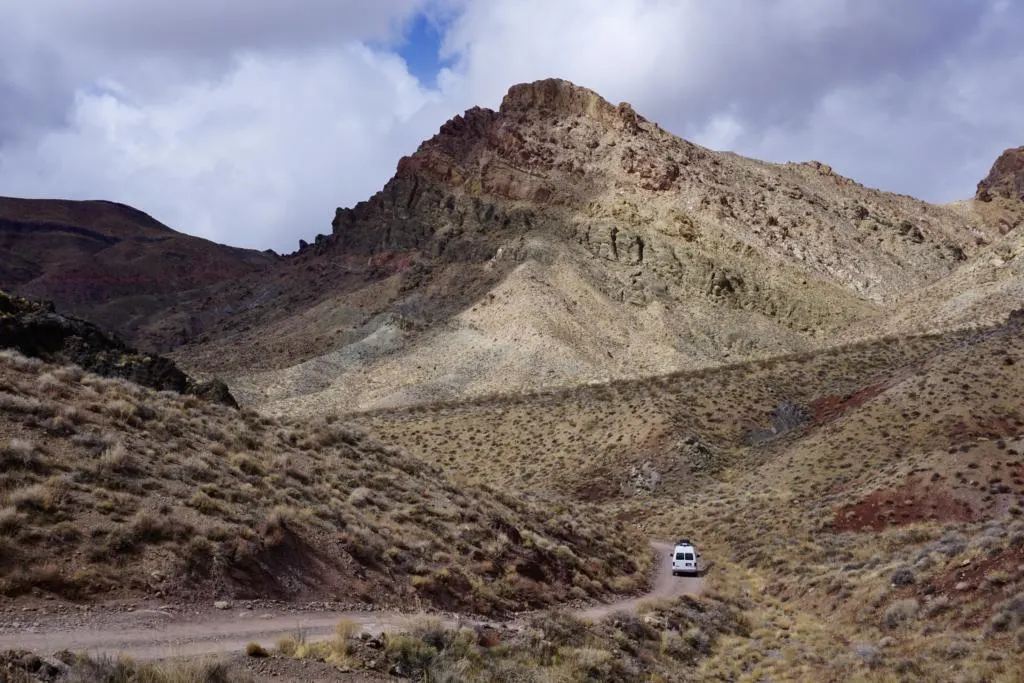
Next, the road empties down into a mountain valley under colorful desert mountain peaks. Then you begin the ascent up and over Red Pass, named for the red dirt in the area. The road switchbacks up the mountainside and the road gets a little bumpier, but nothing that your average high-clearance vehicle can’t handle.
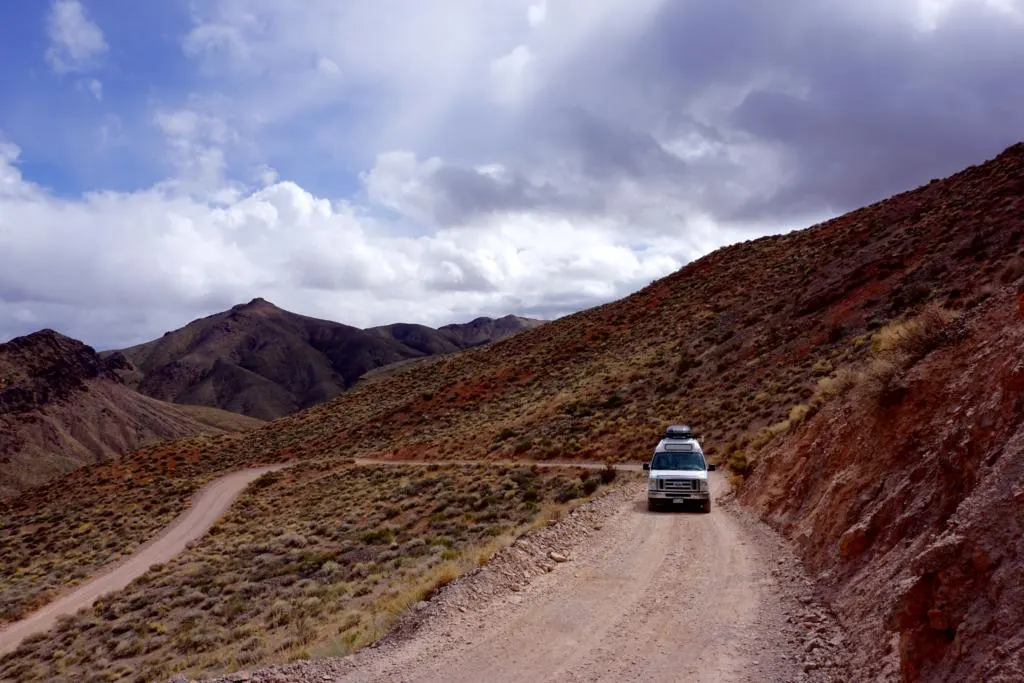
At the top of Red Pass (Elevation: 5250’), the views in both directions are incredible. To the east, you can admire the winding road you just drove up. And to the west, you can see where you are headed.
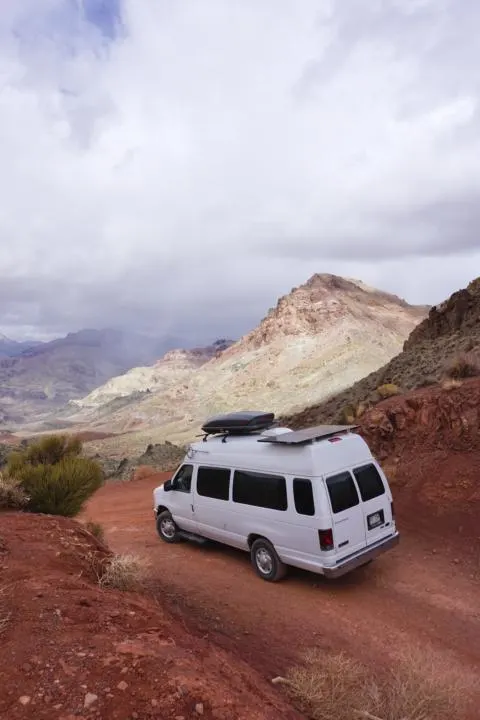
The mixed clouds even dropped some big fluffy snowflakes as we made our way over Red Pass. But it was nearly 50 degrees, so it was a curious time for snow. The Titus Canyon road then makes its way down the other side of Red Pass. The next destination is Leadfield Ghost Town.
About halfway to between Red Pass and Leadfield there is one really gnarly section of switchbacks. This was the only place on the whole drive where high-clearance was absolutely essential. And even then, it required some very intentional route finding to avoid bottoming out. However, our extended wheelbase campervan makes some obstacles a little extra tricky. So a more typical high-clearance vehicle would probably have no trouble.
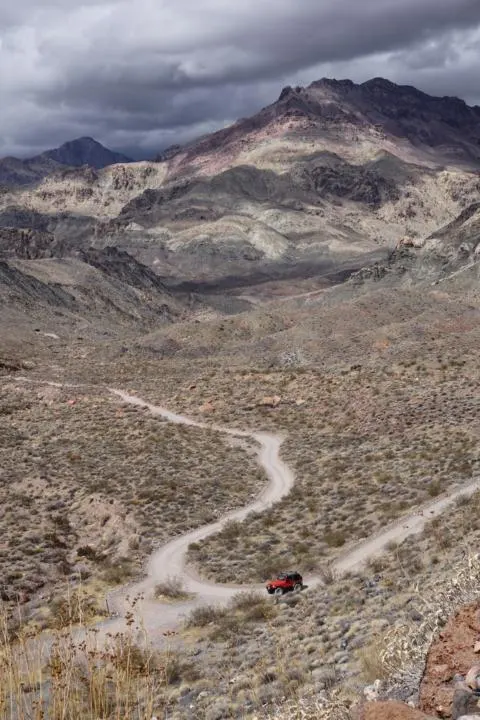
Leadfield Ghost Town
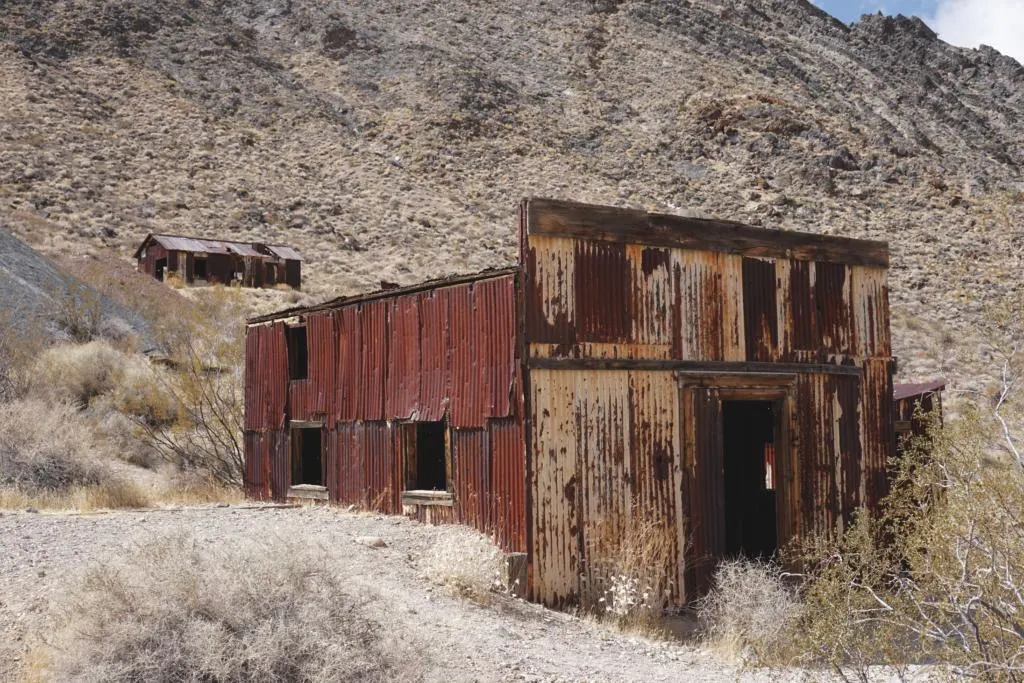
All that’s left of the 1920’s mining boom town Leadfield are a couple of structures, cement foundations, and defunct mine shafts. But the town was doomed from the start because the claims of mining riches were a lie. A cunning swindler by the name of C.C. Julian planted lead in some prospecting holes, all in an elaborate scheme to fool investors. This prospecting scam drew at least 300 people to this harsh environment in search of riches. The town itself really only lasted one year!
But Leadfield makes a good rest stop before entering Titus Canyon. It’s cool to imagine our fellow humans trying to make a living in this beautiful but unforgiving landscape.
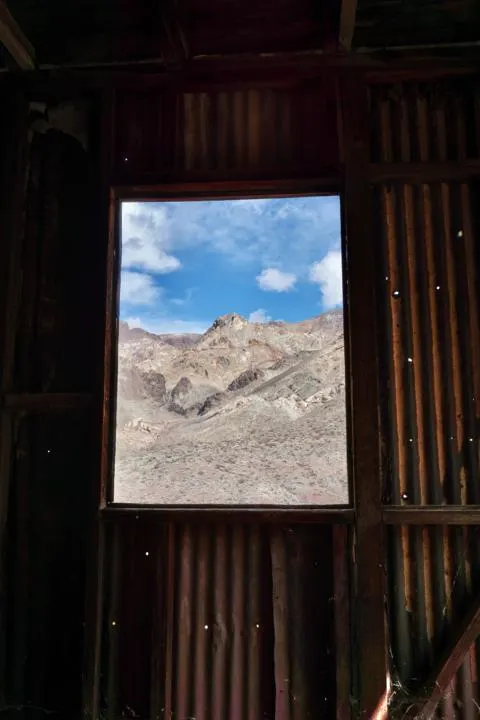
Titus Canyon
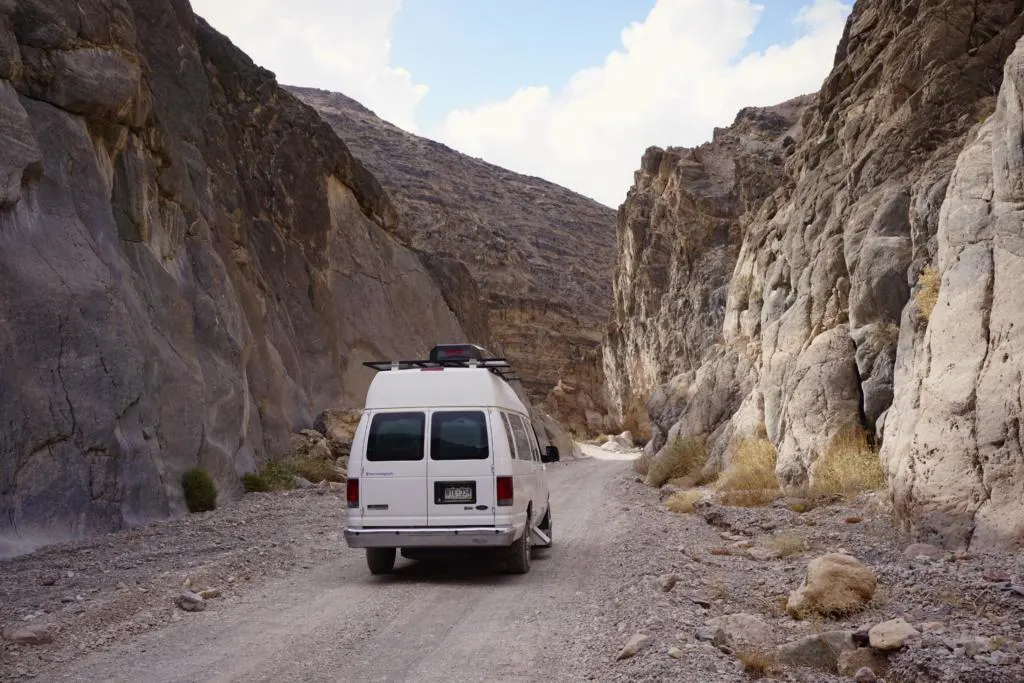
Now onto the main event. Just after Leadfield, the road enters the top of Titus Canyon. The limestone cliffs towering high above the road are truly an incredible sight to behold. You may have seen canyons like this before, but probably never out the windshield of your car!
About 1.5 miles from the “entrance” to Titus Canyon, you will pass Klare Spring and some Native American petroglyphs on your right. This small water source is a rare treasure in an otherwise arid environment. Bighorn sheep and other wildlife depend on Klare Spring for survival. Native Americans left petroglyphs on the rock near the spring. The site is an irreplaceable part of history, so only look, or take photos.
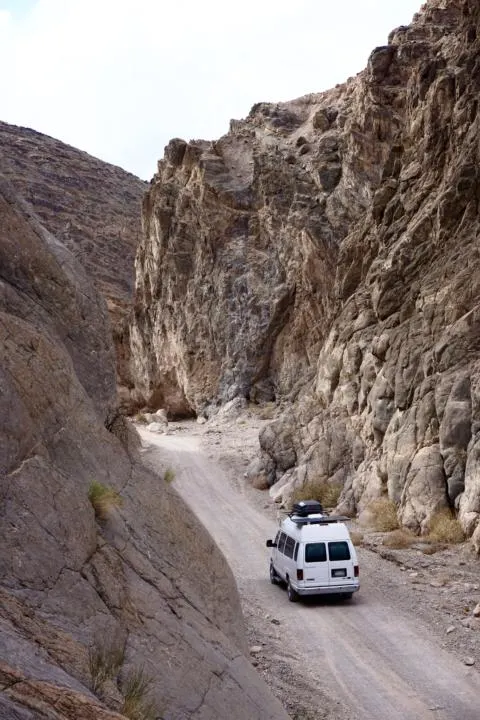
The bottom half of Titus Canyon is where the most narrow sections are. The canyon is barely wider than our van in some places. As the road snakes through the canyon floor, it’s hard not to marvel out the windows around every turn.
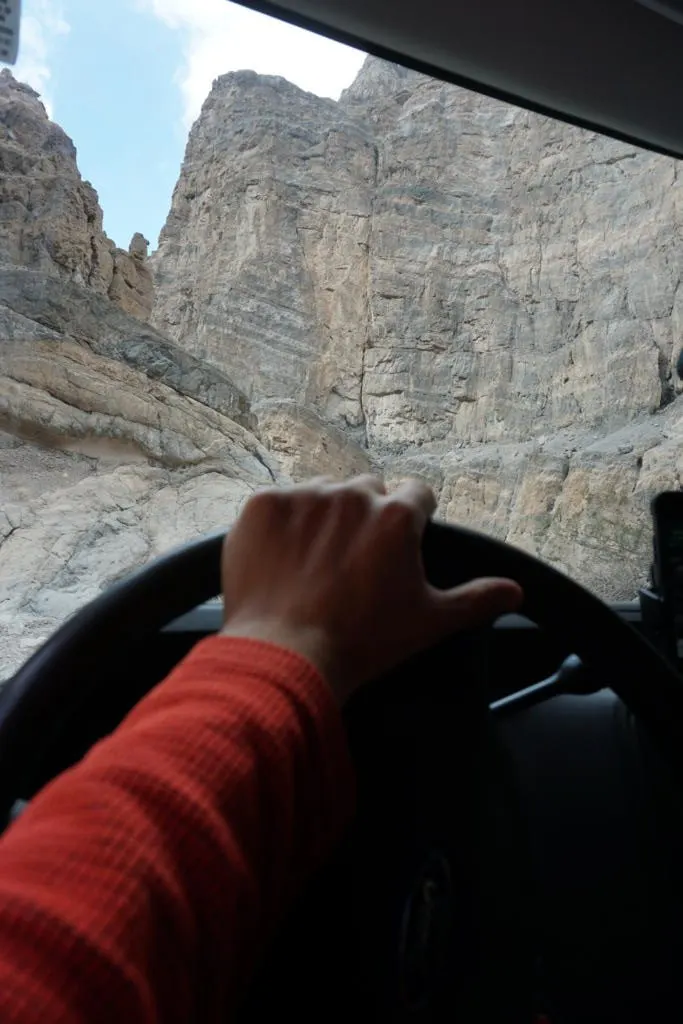
Titus Canyon eventually emerges back out into Death Valley National Park. At this spot there is a vault toilet and parking area. The final 2.6 miles are open to two-way traffic. So visitors are welcome to drive up to this point and then continue up into Titus Canyon on foot. But watch out for oncoming traffic.
Titus Canyon “Extra Credit” Adventures
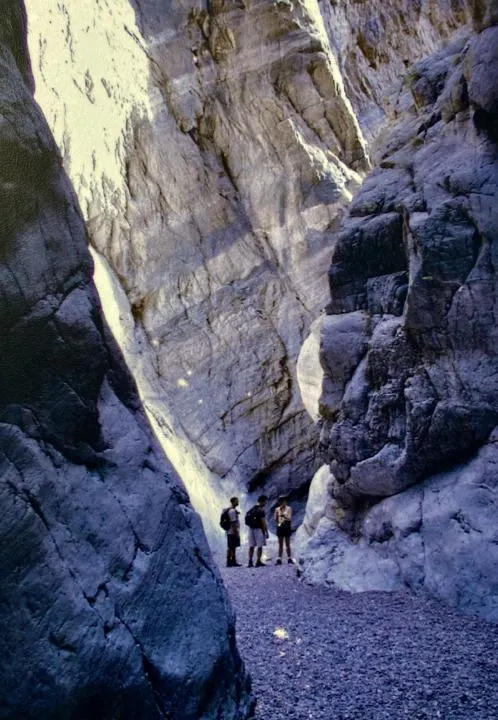
Fall Canyon Trail
If hiking Titus Canyon next to vehicles kicking up dust doesn’t sound that fun, you should check out Fall Canyon. It offers a very similar vibe to Titus Canyon, but without any vehicle traffic. It’s about 6.6 miles round-trip to get to the dry fall, but you could still experience a lot of the beauty if you turn back early. The beginning of the trail skirts along the mountains for about a mile, but then quickly turns into tall canyons.
The trailhead for Fall Canyon is right at the exit of Titus Canyon. This is the end of the two-way section, so people can access the trailhead without driving Titus Canyon. [Alltrails]
Thimble Peak Trail
A 3.2 Mile, 1,600 ft elevation climb to an epic peak. Park at the top of Red Pass and locate the trail on the south (left) bank of the road. The final part of the hike requires some minor scrambling. But the views from the top are worth the climb. [Alltrails]
Titanothere Canyon Trail
A rugged and unmaintained canyon hike at the south end of the Grapevine Mountains. It was named after the Titanothere dinosaur remains that were found in it. This out-and-back is commonly hiked to Lostman Spring for an 8.6-mile round-trip hike. The beginning of the hike is at these coordinates.
Upper Titus Canyon
Couldn’t find much information about this one, except for this little blurb from the National Park website “To explore the upper drainage, park where the main fork joins the road 0.7 miles below Leadfield. Hike up the gravel wash through a broad, colorful valley. A good goal is the narrow side canyon from the right at about 2.5 miles.”
Takeaway | Titus Canyon
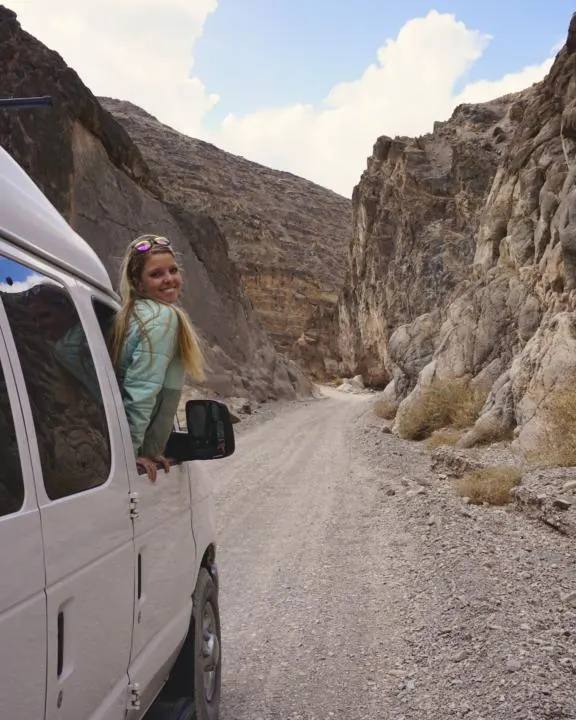
Driving Titus Canyon road is an epic adventure that you wont forget. It’s a great way to experience a variety of terrain at Death Valley National Park without hiking on foot. In our years of traveling, we’ve never driven a road quite like it. The slot canyon vibes are something that is typically only experienced via hiking trails.
However, Titus Canyon road is probably not a good fit for everyone. The off-road conditions are nothing like your typical paved scenic drive in a National Park.
While 2wd was adequate, we found that high-clearance was definitely essential in a few areas. Some technical driving was needed to navigate these obstacles. There was also lots of sharp rocks, so it’s highly recommended to have a full-size spare tire. We also aired down our tires to help with ride-smoothness and traction.
It took us much longer than 3 hours to complete all of Titus Canyon road. But that’s because we drive very slowly over rough terrain in our campervan. Plus, we stopped many time to eat and take photos. So it took us about 6 hours to complete the whole drive. But Titus Canyon is all about the journey. Enjoy!
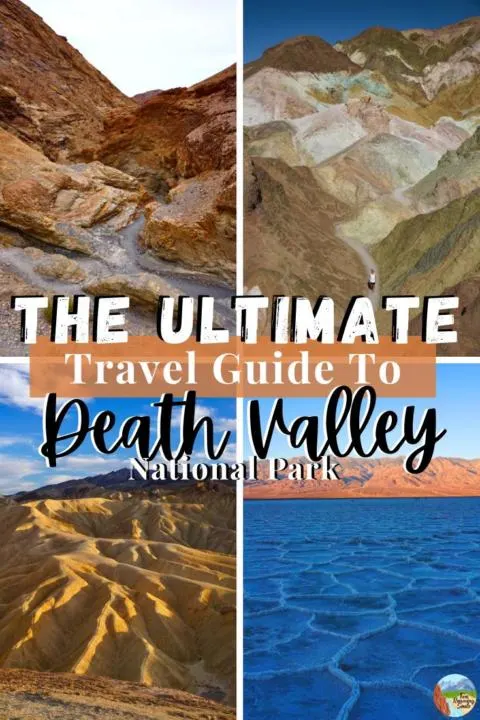
Check out our other favorite Death Valley highlights: Ultimate Guide To Death Valley National Park
Help Share ‘Titus Canyon’ On Pinterest
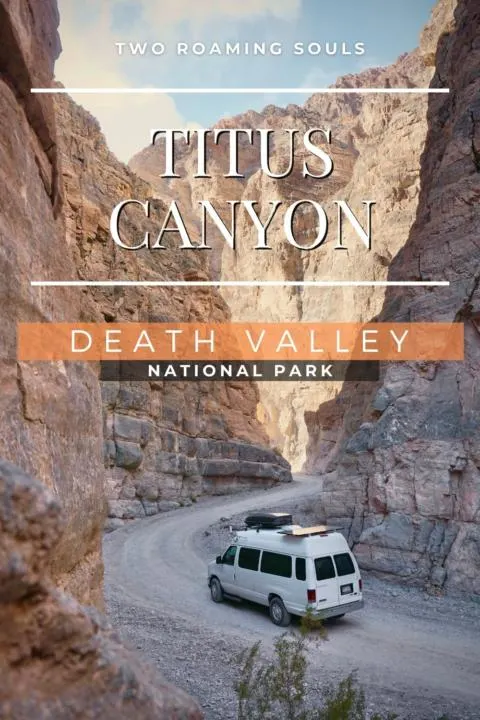
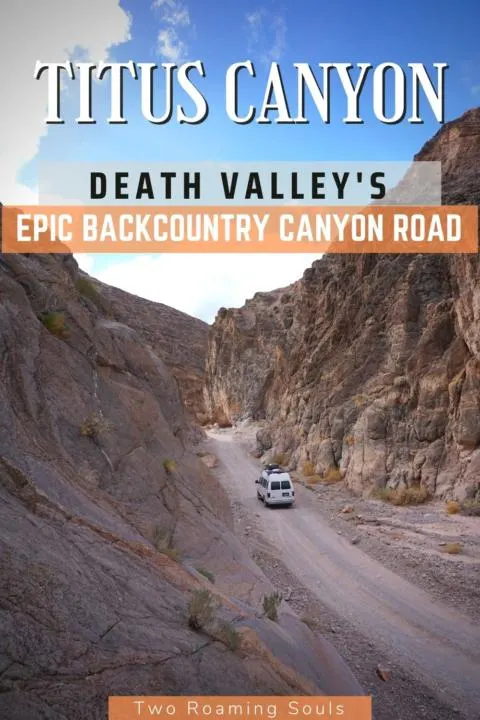

The Ultimate Guide To Death Valley National Park - tworoamingsouls
Wednesday 7th of April 2021
[…] You can access this road in a 2wd, high clearance vehicle when road conditions are dry. If road conditions get wet, you may need a 4×4 vehicle. But Death Valley is known for being the driest National Park, so it happens in rare occasions. Check with a ranger if you question the road conditions. But this should definitely add this scenic drive to your Ultimate Guide To Death Valley National Park if you have the time. {Read our Complete Titus Canyon Guide Here} […]